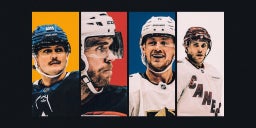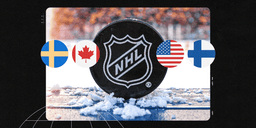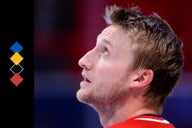BROSSARD, Quebec — As Aleksander Barkov, the captain of Team Finland at the 4 Nations Face-Off, was leaving the podium after speaking to the media following his first practice of the tournament, he was asked one final, simple question.
Which Finland teammate had he already played with on the same forward line?
Barkov didn’t even take two seconds to think about his answer.
He quickly mentioned playing on a line with Patrik Laine at the 2016 World Cup of Hockey, then realized he also played with Sebastian Aho on that line. He found that funny. Obviously he’s played on a line with his Florida Panthers teammates Anton Lundell and Eetu Luostarinen. And he’d played with Mikael Granlund at the 2014 Winter Olympics in Sochi.
“I came here and I knew every single person, I had met him before, I talked to him before,” Barkov said Monday, “and obviously it helps.”

GO DEEPER
4 Nations Face-Off predictions: Picks for champ, USA vs. CAN, MVP and more
The fact is, Barkov was nowhere close to giving a complete answer.
At the 2012 Under-18 World Championship, Barkov played on a line with Teuvo Teräväinen. At the 2013 World Junior Championships, Barkov played on a line with Joel Armia, Artturi Lehkonen and Teräväinen at various points of the tournament.
Therefore, Barkov has already been linemates with at least eight other forwards on Team Finland, six of whom he has never played with in the NHL.
This is just one of the advantages Team Finland has in a tournament like this, despite an apparent deficiency in talent compared to Canada, the United States and Sweden. Whenever Finland is faced with what appears to be a disadvantage on the international stage — and that is definitely the case at 4 Nations with injuries to Miro Heiskanen and Rasmus Ristolainen on what was already a thin blue line — their players almost always beat the odds and find themselves with a medal around their necks at the end.
The familiarity within the group, combined with that international success, means several of these players have experienced winning on big stages together, often on the same line. The 2016 World Junior Championship, for example, was played in Helsinki, and Finland ran through Canada, Sweden and Russia in the elimination round to claim gold on home soil. Laine and Aho played together on the top line in the gold medal game, while Roope Hintz and Mikko Rantanen played together on the third line.
“Of course, there was a lot of skill on that team, too, but I think the biggest thing usually for Finnish teams is that we play really tight,” Hintz said in a recent interview. “Of course, at that time, we had lots of friends on the team. Everyone was friends with each other. I think it was just easy to play with everybody.”
One of the biggest challenges for national teams in tournaments like this is finding combinations that work and manufacturing chemistry in a hurry. That is why Canada, the U.S. and Sweden each held full practices Monday, complete with forward lines and defense pairings: to get an early sense of what works and what doesn’t.
Finland didn’t do that because, in some ways, it didn’t have to. It had an optional skate, with 11 skaters and two goalies taking part in some pretty standard drills for less than 30 minutes. Head coach Antti Pennanen wasn’t even on the ice. He explained that Finland was saving its energy for the games.
That’s a luxury a team with so much familiarity has that the other three teams in the 4 Nations don’t.
“We want to do things together,” Finland general manager Jere Lehtinen said in an interview Saturday. “I think that’s helped in past years, they’ve been together enough, played together enough, those combinations have played together.
“That’s helped us to come together quick.”

GO DEEPER
It’s a new beginning for the NHL and ‘best-on-best’ hockey
But while that is the source of one of Finland’s biggest advantages in international hockey, particularly in a tournament as short as this one, it is not the only one. There are other reasons why Finland has medaled at seven of the last 10 Olympic tournaments, including four of the five Olympic tournaments that included NHL players.
Counting Finland out before a tournament begins based on how it looks on paper would be unwise.
Familiarity is one thing, but there is also a Finnish way of playing hockey that can be highly effective in a tournament format where a strategy that works for one game at a time is often all you need. And for the Finns, that strategy is clear, at least to one of its most prolific offensive players.
“I feel like Finns overall, everybody knows their role, there’s no egos involved. We know what we’re here to do, it’s to play for our country,” Laine said in a recent interview. “Everybody knows where they’re at and we’ll try to win for each other, so I think that will be the biggest strength of our team. Then we’ll just try to shut everybody down. Play some normal Finnish hockey and just shut everybody else down. Sandpaper hockey. It works.
“It’s not the most entertaining way to play. But it’s efficient.”
The level of buy-in to that way of playing is ingrained in Finnish players from a young age, so they can quickly get back to it when they reunite at these events.
“I think, or I know, actually, it all comes from dedication to whatever we decide to do, whatever systems we decide to do, however we decide to play in the tournament,” Barkov said when he was named Finland’s captain on Jan. 30. “Everyone buys into it, there’s no problems with that. Everyone knows what needs to be done and what his role is. The team is obviously bigger than one individual, so that’s always been a huge advantage for Team Finland because everyone buys into the system and buys into everything we do.
“That’s my theory, and I think every single Finnish guy would say the same thing.”
Yes, that holds up.
“I just think it’s that every guy can adjust to every situation. Guys are disciplined. We play a good team game, everybody plays for the team. I think that’s it,” Armia said back in December when he was named to the team. “Growing up, it’s all about the team game.
“Always.”
“Teamwork is the main thing for us,” Pennanen said Monday. “I think it’s part of Finnish hockey, to be a good team.”

GO DEEPER
For the NHL’s lost generation of Olympians, 4 Nations Face-Off is a reminder of what could have been
And the reality is that many of their opponents in this tournament have seen it firsthand. When Finland won that 2016 World Junior Championship at home, the Canadian team that lost to them in the quarters included Brayden Point, Mitch Marner and Travis Konecny. The Swedish team that lost to them in the semis included Gustav Forsling, Adrian Kempe and Joel Eriksson Ek. The U.S. entry in that tournament, which didn’t face Finland but watched it win, included Matthew Tkachuk, Zach Werenski, Auston Matthews and Charlie McAvoy.
“My experience in playing against teams from Finland in the past is that they’re hard to play against,” Team USA coach Mike Sullivan said Monday of his first opponent in this tournament (8 p.m. ET Thursday). “They’re a competitive group, they’re a proud group, and I would anticipate it will be a hard-fought, competitive game.
“You know, talent alone is not going to win this tournament because every team has it. And Finland’s no different.”
The notion of being an underdog in any given tournament is not foreign to anyone on Team Finland. It is their comfort zone, in many ways.
But in many ways, it’s also not their comfort zone, because they don’t care what anyone else thinks. They don’t know they are underdogs, because being considered an underdog has never stopped them from having international success before. And they know the exact recipe it takes to achieve that success.
“I don’t think we have talked about (being the underdog) because we know our strengths,” Barkov said Monday. “We know what to do, we know how to play.”
(Photo of Finland winning the 2016 World Juniors: Roni Rekomaa / AFP via Getty Images)
